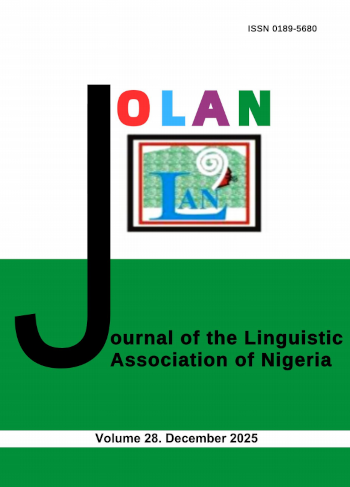A Contrastive Analysis of consonantal phonemes and Phonotactics of Igbo and Ịjo̩ (Izo̩ n)
Keywords:
Ijo, Igbo, language learner, language pedagogy, phonemes, phonotacticsAbstract
This study examines a contrastive analysis of the phonology of the Igbo and the Ịjọ languages. While Igbo is a major and national language predominantly spoken in the south-eastern region of Nigeria, Ijo̩ is a minority language in the Niger-Delta region. The paper analyses the different phonological structures of the two languages within the theoretical framework of the Contrastive Analysis. Descriptive method is used to analyse data obtained through interviews using purposive sampling. The study discovers that Contrastive Analysis is prognostic; learner-oriented and focuses on the language pedagogic needs of the Second Language or Alternate Language learner which in-turn provides input for the curriculum design for the L2 or AL learner. Several areas that may pose learning problems for the Ịjọ learner of Igbo and vice versa are identified at segmental, syllable, and tonal levels. These pedagogic problems are predicted based on the differences that exist in the phonology of the two languages. The nasalized vowels of Ịjọ and some aspects of the Ịjọ phonotactics would constitute areas of difficulty for the Igbo learner of Ịjọ. This study is imperative given the large population of Igbo and Ijo̩ speakers in the Niger-Delta and south-eastern regions respectively for some reasons due to proximity.
References
Abdulraman A. H. 2017. Contrastive Analysis of the Sound Patterns of English and Arabic Languages. M.A Thesis.
Abdi N. 2017. Contrastive Analysis and Error Analysis Language. Retrieved December 16, 2017, from http://medicine.tums.ac.ir/fa/Users/N_abdi/.pdf
Akintola B. 2005. When borrowing is counter-productive: The English-Yoruba example. In Globalization and the study of language in Africa, ed. O.Z. Ndimele, 74--90. Port-Harcourt: Emhai Press.
Alatis J. (ed.) 1968. Contrastive Linguistics and its Pedagogical Implications. Washington: Georgetown University Press.
Awobuluyi O. 2015. Yoruba metalanguage. Lagos: Nigerian Educational and Research Development Council.
Ayegba M. 2011. Contrastive Analysis of English and Igala Phonology and Morphology. MA dissertation. University of Nigeria.
Babarinde O. 2015. Knowledge of phonotactic constraints in Yoruba: A necessary tactic behaviour for linguistic competence in the language. Language Matters: Studies in the Languages of Africa. 45(1), 47-62.
Bell RT. 1981. An Introduction to Applied Linguistics: Approaches and Methods in Languages Teaching. London: Bratsford.
Blevins J. 1995. The Syllable in Phonological Theory. In, J. Goldsmith (ed.). The Handbook of Phonological Theory. Cambridge: Basil Blackwell: 206-244.
Bland ML. 2017. The use of contrastive studies in linguistics. Journal of Modern Languages. 10(1). 75-84
Burens P. V. 1980. Contrastive Analysis. Current Issues in Linguistic Theory. Vol. 1.
Crystal D. 2003. A dictionary of linguistics and phonetics. 4th ed. USA: Blackwell.
Davies A. 2007. An Introduction to Applied Linguistics from Theory to Practice. Edinburgh: Edinburgh University Press.
Dulay H. & Burt M. 1974. Natural Sequences in Child Second Language Acquisition. Language Learning, 24:37 – 53.
Gholami EM. 2009. An analysis of lexical errors of Persian learners of English in hyponymy, polysemy, and synonymy. Electronic English Journal, 1, 42-50.
Flege J. 1995. A Critical Period for Learning to Pronounce Foreign Languages? Applied Linguistics, 8 (2): 162 – 177.
Flynn S. 1987. A Parameter Setting Model of L2 Acquisition. Dordrecht: Reidel.
Fries C. 1945. Teaching and Learning English as a Foreign Language. Ann Arbor: University of Michigan Press.
Haspelmath M. 2010. Comparative concepts and descriptive categories in cross-linguistic studies. Language, 86(3). 663-687.
James C. 1980. Contrastive Analysis. London: Longman.
Johnson S. 2015. The Uses of Error Analysis and Contrastive Analysis I. English Language Teaching, 29, 3: 246- 253.
Lado R. 1957. Linguistics Across Cultures: Applied Linguistics for Language Teachers. Ann Abbor: University of Michigan Press.
Larsen-Freeman D. & Long MH. 1991. An Introduction to Second Language Acquisition Research. London. Longman Group Limited.
McCarthy J. 2002. A Thematic Guide to Optimality Theory. Cambridge: Cambridge University Press.
Mekiliuwa O. 2016. An Introduction to Applied English Linguistics. Lagos: Fordson Part and Sons
Odlin T. 1989. Language Transfer: Cross-Linguistic Influence in Language Learning. New York: Cambridge University Press.
Omachonu, G. S. 2001. Igala morphological processes. Nsukka Journal of African Languages and Linguistics, 2, 55-65.
Oyebade O. 1992. Phonology II. In Introduction to linguistics, ed. O. Yusuf, 23-36. Ilorin: University of Ilorin Press.
Peterson R. 2015. The essence of contrastive studies. Lagos: Zenith Press
Richards J. 1971. “Error Analysis and Second Languages Strategies”. Language Sciences, 17:12 – 22.
Spada N. & Lightbown PM. 2002. “Second Language Acquisition”. In N. Schmitt (ed), An Introduction to Applied Linguistics. London: Hodder Education: 115 – 132.
Stockwell R. P., Bowen J. D. & Martin, J. W. 1965. The Sounds of English and Spanish. Chicago: University of Chicago Press.
Weinreich U. 1953. Language in Contact. The Hague: Mouton.














